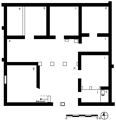| Context: | Olynthus |
| Type: | House |
| Summary: | Well-built house of regular plan in the Villa Section of Olynthus. |
| Date: | ca. 432 BC - ca. 348 BC |
| Dimensions: | 16.83-17.00 m. EW x 15.80-16.40 m. NS |
| Period: | Classical/Late Clas. |
Plan:
House of regular Olynthian type, with central courtyard, pastas, rooms along north, kitchen-complex with bath and "flue" in southeast, and storage room in southwest corner of the house.
Date Description:
No earlier than 432 BC, when Olynthus was "synoecized"; destroyed by Philip II in 348 BC. Probably not built before ca. 400 BC, since most of the houses in this part of the city probably date to the fourth century.
Other Notes:
The Villa of the Bronzes is a well-built and well-preserved house, and had been heavily burned, particularly in the northern part. A number of weapons found in the court and other rooms, including a shield, a sword, three knives, two spearheads, five arrowheads and thirteen slingbullets, attest to the heavy fighting here during the capture of the city, and led to the naming of the house.
The house is quite regular in plan. The court takes the common position in the center of the south side of the house, and the pastas opens to the court through a colonnade of two columns and two engaged pilasters. Two stone Doric capitals and a pilaster capital from this colonnade were found near the bases. To the north of the pastas are three rooms, two connected by a pillar partition and forming a suite with a light well like that in the
Although similar in plan to the
The house was well built and appointed. Its south and west walls were built of drafted ashlar masonry, rare at Olynthus, and the court paved with cement and stone slabs. Six of its eleven rooms were painted, some with molded plaster, and room b had a mosaic floor.
The court, of about average size, was drained to the street via a channel and terracotta pipe. Most of the finds here seem to be remains of the final battle for the city: a shield, sword, three knives, two spearheads, and seven slingbullets. The skeleton of a large calf or small cow was also found on the floor of the court, perhaps another casualty of war.
As at the
The two rooms north of the pastas (a and b) form a suite with light well similar to that in the
This suite was used quite differently, however, from that in the
The light well (a), on the other hand, had an earth floor on which were found many ashes and traces of burning, apparently not only from the fire of the destruction but from "continuous fires here" during the use of the house. These fires might have heated the main room of the suite. There is no reason to think that this was a cooking area: no cookingwares or bones were found here or nearby.
In the northwest corner of room a was an odd egg-shaped pithos sunk into the floor, and in the center of the west wall of the room were 20 nails, apparently the remains of another piece of furniture. Several small iron bosses were found in this room although their exact locations were not noted; they too might belong to this furnishing. Near the furnishing were two more fancy double-nozzled lamps like those in the main room, personal articles like a bone spatula, a finger ring with a decorated bezel, and two black-glazed plates. On the other side of the room near the pillar partition were at least 25 saucers and another plate, while many other vases were scattered in this room, and in the southwest corner was a large shallow pot. The interpretation of this area is difficult: presumably it serviced the main room (b), but the use of the pithos, the saucers and other objects is problematic.
The kitchen complex in the southeast corner of the house consisted of a large kitchen, a "flue" separated by a pillar partition, and a cement-paved bath with a tub still in situ (rooms i, j and k). The flue and bath were separated by only a light partition, which left its impression on the yellow plaster of the bath. A fragment of a lower grindstone in the kitchen might suggest that this, like the kitchen in the
The floor of the flue was covered with a layer of ash, charcoal, burned earth and fragments of animal bones, up to 3 cm. thick; this was apparently a cooking room like the flue in the
The other corner of the house was taken up by a large storeroom (g), like that in the
As at the
Sources Used:
